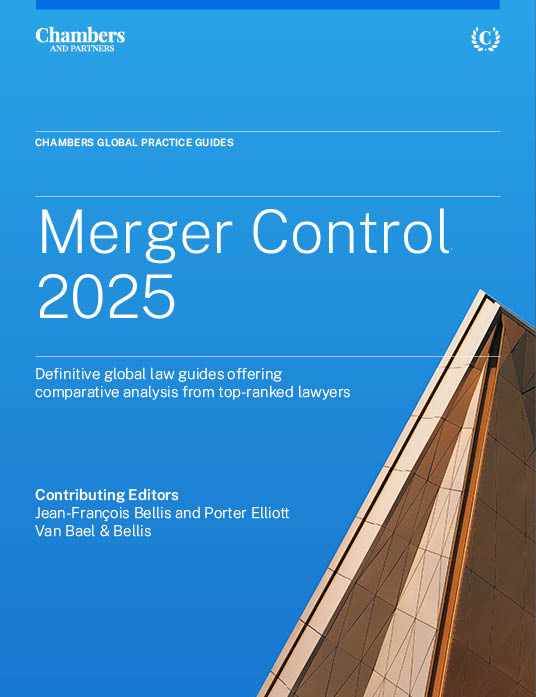
Merger Control 2025
The Merger Control 2025 guide features close to 40 jurisdictions. The guide provides the latest legal information on enforcement authorities; notification requirements; foreign-to-foreign transactions; joint ventures; third-party rights, confidentiality and cross-border co-operation; appeals and judicial review; FDI and subsidy review; and the authorities’ current competition concerns.
Last Updated: July 08, 2025
Compare law and practice by selecting locations and topic(s)
Select Locations

Select Topic(s)

Please select at least one location and one topic to use the compare functionality.
As M&A Remains Sluggish, the Merger Control Sands are Shifting
After a slow 2023, many market analysts predicted a significant recovery in M&A activity in 2024. This recovery did not materialise. In fact, the number of transactions declined in 2024 compared to 2023, although total deal value slightly increased, buoyed by a few very large deals, such as ExxonMobil’s USD64.5 billion acquisition of Pioneer Natural Resources.
Undeterred speculators had high expectations heading into 2025, which so far have not been met, as US tariff hikes and other policy measures, as well as geopolitical instability, have exacerbated market uncertainty and risk aversion. Whether the second half of 2025 will see the beginning of the long-anticipated M&A rebound remains to be seen. Either way, from a merger control perspective, it is clear that 2025 will be remembered as an unusually tumultuous year, with significant changes and increasing uncertainty prevailing in major jurisdictions around the globe.
Changing landscapes across key merger control jurisdictions
European Union
As of 1 December 2024, there is a new EU Competition Commissioner: Teresa Ribera has replaced Margrethe Vestager, who had held the position for the previous decade. Commissioner Ribera enters the job with a strong background on environmental issues – which is part of her new portfolio – and a clear mission from European Commission President Ursula von der Leyen to “modernise the EU's competition policy to ensure it supports European companies to innovate, compete and lead world-wide and contributes to our wider objectives on competitiveness and sustainability, social fairness and security”. On merger control specifically, President von der Leyen has ordered a review of the Commission’s horizontal merger control guidelines to “give adequate weight to the European economy’s more acute needs in respect of resilience, efficiency and innovation”.
This follows the September 2024 publication of the much-discussed “Draghi Report”, which describes the need to increase European productivity as “an existential challenge” requiring “radical change” in a number of areas, one of which is competition law, including merger control. According to the Draghi Report, the strict application of the EU merger control rules has generally been good for competition, but it has also made it difficult for European companies in certain key industries to scale up as needed to be able to invest more in innovation and compete more effectively on the global stage with rivals from the United States, China and elsewhere.
Commissioner Ribera and her staff at the Directorate-General for Competition are currently reviewing both the Commission’s horizontal and non-horizontal merger guidelines. What the new guidelines will look like when they eventually come out and what practical effect they will have, if any, on the Commission’s assessment of mergers, especially those between European companies, remain to be seen.
Meanwhile, the issue of whether and where in the EU a merger may need to be filed has become increasingly complex. As has been the case since the first EU Merger Regulation (EUMR) in 1989, transactions that do not meet the thresholds of the EUMR may be subject to review by the competition authorities of EU member states whose national filing thresholds are met. However, an increasing number of EU member states are now adopting “call-in” powers that allow their competition authorities to take jurisdiction over transactions that fall below their filing thresholds and would otherwise not require merger control review. As a result, it is no longer possible to rule out the review of below-threshold mergers in these member states.
There is also the possibility that mergers that are “called in” by a member state could subsequently be referred to the Commission for review, possibly even after closing has taken place, significantly lessening the legal certainty once enjoyed by merging parties.
United States
The election of President Donald Trump to a second, non-consecutive term has led to considerable upheaval at the two federal agencies responsible for US merger control enforcement. Former Chair of the Federal Trade Commission (FTC) Lina Khan, whose envelope-pushing interventionism made her a polarising figure on both sides of the aisle, has been replaced by Andrew Ferguson, who was promoted from FTC commissioner to Chair. Trump also dismissed Khan’s fellow Democratic commissioners, leaving only Republicans as FTC commissioners. Meanwhile, Gail Slater replaced Jonathan Kanter as head of the Antitrust Division of the Department of Justice.
Despite some clamouring to scrap the 2023 Merger Guidelines issued under the Biden administration and revert to the previous guidelines, both the FTC and Department of Justice have now indicated that this will not happen. Nevertheless, there will no doubt be changes in how mergers are reviewed in the US.
Under Ferguson and Slater, the US agencies are widely expected to take a more open view than their predecessors to remedies as a means of solving competition concerns. This willingness to find a way to clear problematic deals may encourage more such details to be filed. This is not to suggest that US merger control enforcement will not continue to be rigorous, especially in certain sectors such as Big Tech. The administration was not known to be soft on merger control during Trump’s first term. Rather, compared to the Biden administration, US merger control enforcement in the current term is more likely to be “old school” than “new wave”.
One new development that merging parties should be aware of is that the US has recently taken a page (or rather many pages) from the EU, introducing a much more detailed Hart-Scott-Rodino (HSR) merger filing form. This new form substantially increases the time and resources needed to file a merger in the US.
United Kingdom
The UK’s voluntary notification regime remains “voluntary” in name only, as the “share-of-supply” jurisdictional threshold allows the UK Competition and Markets Authority (CMA) significant discretion in deciding which deals it considers to merit review. Envisaged changes to the law, the current government’s priorities on growth and investment, and the CMA’s reaction to the government’s steer probably foretell a less assertive approach than was witnessed in the CMA’s post-Brexit heyday. Indeed, the CMA has indicated that it may opt not to investigate certain international deals that are already being investigated by other authorities, such as those of the EU or US, or where remedies offered in other jurisdictions would likely resolve any UK concerns.
Still, the CMA remains a force to be reckoned with. Merging parties that overlook the UK as a merger control jurisdiction do so at their peril, especially in the case of deals with a clear UK nexus.
Australia
While the UK maintains its voluntary filing regime, Australia is joining the vast majority of merger control jurisdictions worldwide that have a mandatory filing requirement and a suspensory regime that makes it illegal to close a transaction before the deal has been approved. The new Australian rules go into full effect in January 2026, and given the relatively low turnover thresholds, it will be interesting to see how the Australian Competition and Consumer Commission (ACCC) handles what will likely be a huge uptick in the number of notifications.
Other jurisdictions
These are only some of the merger control jurisdictions that companies must bear in mind when seeking regulatory approval of their mergers. It is also not unusual for global deals to require notification and approval in countries such as Brazil, Canada, China, Japan, South Korea and Turkey, to name just a few.
Clearly, the challenges that both in-house and external counsel face on how to obtain merger control approvals as quickly and efficiently as possible remain acute. This makes having a clear guide such as this one all the more essential. Indeed, the Chambers Merger Control 2025 guide provides answers to all the most pressing questions companies and their lawyers face with every notifiable transaction.
Filing location
For starters, where does the deal need to be filed? This is a crucial question, as there are potentially serious consequences for failing to make a required merger control filing, including the imposition of heavy fines. Unfortunately, it can be tricky to determine where filings are required in a given case.
Although an ever-increasing number of countries have some form of merger control law, there remains very little standardisation, with each merger control regime continuing to have its own test to determine which transactions amount to a notifiable event. Some jurisdictions catch only changes in control, while others also cover certain acquisitions of non-controlling minority stakes.
Moreover, every jurisdiction has its own set of filing thresholds based on various factors, such as the parties’ revenues, asset value, market share, and the size of the transaction. An increasing number of authorities now also have “call-in” powers. Given this, determining where to file requires a careful country-by-country analysis. As such, each chapter of the 2025 edition of the Chambers Merger Control guide indicates whether that jurisdiction has such powers and whether it has in fact called in below-threshold transactions.
A new challenge faced by merging parties is the possibility of having to make separate, potentially very onerous filings under the EU Foreign Subsidies Regulation (FSR), distinct from any merger control filing that may also be required. The FSR requires, inter alia, notification to and prior approval by the Commission of certain transactions where one party is established in the EU and the other (typically the acquirer, but also possibly a merging party or joint venture partner) benefits from “financial contributions” meeting certain monetary thresholds. Obtaining FSR approval is proving to be a major additional challenge for companies to overcome before they can close their deal.
Moreover, an increasing number of countries (virtually every EU member state, as well as dozens of non-EU countries) now have foreign direct investment (FDI) legislation that may require additional filings and approvals. Although neither FDI nor subsidies fall within what one traditionally has in mind when speaking of “merger control”, they represent significant further hurdles now faced by merging companies.
Substantive reviews
Once it has been determined where merger control filings need to be made, the next question is what the regulatory reviews will entail and what needs to be done in order to obtain approval in each jurisdiction. Again, each merger control regime has its own test for determining whether a given transaction will be approved – while the approach may be broadly similar across jurisdictions, there are nuances in each that are important to understand.
For example, is the legal test for assessing mergers based on maintaining effective competition, avoiding the creation or strengthening of a dominant position, or some other standard? Are vertical mergers subject to the same level of scrutiny as horizontal mergers? How are efficiencies considered by the regulator in its assessment? Is the agency’s analysis based purely on competition law principles or are there other (eg, public interest) considerations at play? What kinds of arguments are most likely to be persuasive to each authority, and how does one ensure a consistent approach across jurisdictions given international co-operation between regulators?
Timing
Of course, another key issue will be how the regulatory process affects timing. After all, there is no such thing as a deal that is not time-sensitive. In every transaction, there is a sense of urgency and a desire to close as soon as possible, ideally the day before yesterday.
This urgency needs to be reconciled with the fact that, with some notable exceptions, most merger control jurisdictions require closing to be suspended until regulatory approval has been granted. As indicated above, Australia has now been added to this group. Taking into account the time needed to prepare the filing(s), which in challenging cases can easily be hundreds of pages long (excluding annexes) in certain jurisdictions, the time spent in “pre-notification consultations” with the relevant authorities before formal filing occurs (an increasingly common practice), and the time it takes for the review process(es) to play out, closing can easily be delayed for a couple of months in simple cases, or for well over a year in more challenging ones.
Reasonable timelines need to be set for the parties, and expectations must be managed carefully. Once again, every jurisdiction has its own procedural rules and deadlines, so co-ordinating the reviews across the world can be a significant challenge. This applies even more so where remedies are required in order to obtain approval in one or more jurisdictions.
Conclusion
For the above reasons (and many more), navigating a global merger control filing and approval process is a complex business, and it is getting more complex every year. The Chambers Merger Control 2025 guide aims to cut through some of that complexity by providing the reader with a practical guide, in a user-friendly format, that covers many of the world’s leading merger control jurisdictions.
The sections in this guide cover the key rules relevant for a merger control filing assessment, including:
- the kinds of transactions that have to be notified (or are subject to review);
- what the filing thresholds are;
- the procedure and timeline for notification and approval;
- the substantive considerations of the authorities; and
- what kind of enforcement record the authorities have.
However, the chapters also go beyond the letter of the law and provide useful information on how these rules are applied in practice. For instance, the sections on applicable fines for failure to file cover not only whether such penalties exist and what their legal maximum is, but, more importantly, whether these penalties are applied in practice and what penalties have been imposed recently.
Although by no means a substitute for seeking advice from experienced merger control counsel, this guide provides clear and practical answers to most of the fundamental questions faced by any company involved in a transaction that requires merger control filings (while also addressing foreign direct investment and foreign subsidies filings and approvals). The reader will find this guide to be a very useful tool for navigating their way through the increasingly complex labyrinth of global merger control.
As with any work of this nature, compiling this guide has been a team effort. With this in mind, we would like to thank all the authors for their contributions, as well as the Chambers team for their diligence and professionalism.

